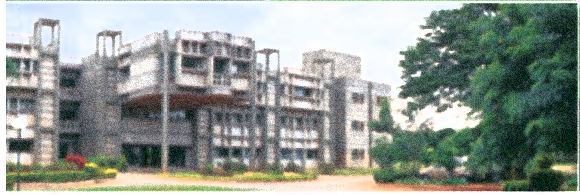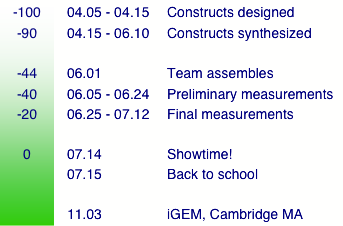Bangalore
From 2007.igem.org
(Difference between revisions)
| (268 intermediate revisions not shown) | |||
| Line 1: | Line 1: | ||
| - | [[Image:NCBS- | + | {|align="justify" |
| + | |On June 1st 2007, a group of undergraduates of various disciplines and from around the country assembled at NCBS, to attempt a 'proof of principle' demonstration. Their mission: to assemble and test a 'genetically engineered machine', a complex network assembled from simple biological parts. You will be amazed how much they managed to achieve in just six weeks! | ||
| + | |[[Image:Ncbs_Logo.jpg|200px|center]] | ||
| + | |- | ||
| + | | | ||
| + | ''The National Centre for Biological Sciences is a research institute located in Bangalore, India. In 2006, a team of graduate students from NCBS was the first from India to participate in iGEM. This year, we are very excited to compete as an all-undergraduate team of six students, from six different colleges located in four cities around India. Now that the summer is over, we hope to take the excitement of iGEM back to our home institutions, and create new teams across India who will participate in future iGEMs.'' | ||
| + | |[[Image:Ncbs.jpg|400px|center]] | ||
| + | |- | ||
| + | | | ||
| + | |align="center"|[http://www.ncbs.res.in/ National Centre for Biological Sciences, Bangalore] | ||
| + | |} | ||
| - | + | <!--- The Mission, Experiments ---> | |
| - | + | {| style="color:#294e9c;background-color:#e1e0db;" cellpadding="3" cellspacing="1" border="1" bordercolor="#1100ff" width="62%" align="center" | |
| - | + | !align="center"|[[Bangalore|Home]] | |
| - | + | !align="center"|[[The Team|The Team]] | |
| - | + | !align="center"|[[The Goal|The Goal]] | |
| - | + | !align="center"|[[Parts Data Sheets|Parts Data Sheets]] | |
| - | + | !align="center"|[[Mathematical Models|Mathematical Models]] | |
| - | + | !align="center"|[[e-Notebook|e-Notebook]] | |
| - | + | |} | |
| - | |||
| - | + | [[Image:timeline.png|center|]] | |
| - | == | + | == == |
| - | + | <font size="2"> | |
| - | + | ||
| - | + | [[Image:igem_bangalore_07.jpg|thumb|550px|center|<font color="green">'''Top to Bottom''':</font><font color="black"> Navneet, Nilesh, Vivek, Vini, Krishna, Varun, E.coli, Shashanka, Mukund, Senthil and Sushant at the NCBS Amphitheatre.</font>]] | |
| - | + | </font> | |
| - | + | ||
| - | + | ||
| - | + | ||
| - | + | ||
| - | + | ||
| - | + | ||
| - | + | ||
| - | + | ||
| - | + | ||
| - | + | ||
| - | + | ||
| - | + | ||
| - | + | ||
| - | + | ||
| - | + | ||
| - | + | ||
| - | + | ||
Latest revision as of 07:20, 24 October 2007
| On June 1st 2007, a group of undergraduates of various disciplines and from around the country assembled at NCBS, to attempt a 'proof of principle' demonstration. Their mission: to assemble and test a 'genetically engineered machine', a complex network assembled from simple biological parts. You will be amazed how much they managed to achieve in just six weeks! | |
|
The National Centre for Biological Sciences is a research institute located in Bangalore, India. In 2006, a team of graduate students from NCBS was the first from India to participate in iGEM. This year, we are very excited to compete as an all-undergraduate team of six students, from six different colleges located in four cities around India. Now that the summer is over, we hope to take the excitement of iGEM back to our home institutions, and create new teams across India who will participate in future iGEMs. | |
| [http://www.ncbs.res.in/ National Centre for Biological Sciences, Bangalore] |
| Home | The Team | The Goal | Parts Data Sheets | Mathematical Models | e-Notebook |
|---|



